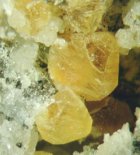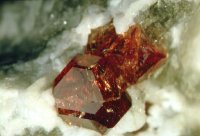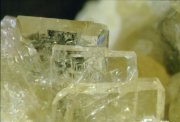 |
|||
|
|||
|
Copyright
Secrets Under the Scope
Before examining those responses, however, we should take a look at micromounters themselves. In the first place, among mineral collectors, micromounters tend to be older than average. In the second, they tend to be more knowledgeable about minerals. Third, they have more experience with collecting, and fourth, they are serious enough about minerals to have invested heavily in expensive equipment. In short, the micromounters have often been through the rest of the hobby, and have finally settled on micromounting as the final solution. Now consider the nine responses to the question "why?". Remember, above all, that a good mineral collection is a collection of representative crystals. Massive material, with the minor exception of the very rare, is acceptable only for cheap and dirty. It's the paperback of mineral collecting. Crystals are the hardbounds and first editions. The first response, therefore, is that many minerals come in small crystals only. It is impossible to make a significant systematic mineral collection without including some very small crystals. Very small crystals need a microscope for proper examination. The second response is that small crystals have a better probability of being closer to textbook "perfection" than large ones. That's because they don't occupy as much space, so they don't crowd each other and become distorted. They are also less likely to be affected by mechanical forces or changes in the environment over their period of growth.
The third is that large crystals have a higher probability of being chipped or broken while being collected. Small crystals are often protected by the walls of the cavity in which they developed. Collectors of micro minerals usually don't have to worry about how many wilbers a crystal has. (A wilber is the largest amount of damage a crystal can sustain and still be acceptable to connoisseur collector David Wilber. It is very small. Two wilbers equate to one ding, and so on up the scale.) The fourth is that more features of crystals and their associations are visible under the microscope. The micromounter therefore has the capability of extracting a greater amount of information from his specimens. The microscope reveals minute inclusions, tiny surface changes, vicinal faces, faint twinning lines, and other features not necessarily visible on a macro scale. Its judicious use amplifies knowledge as well as vision. Response five is that it is much easier for a collector to find good small crystals in the field than to find good large ones. Fans of self-collected minerals know the difficulty inherent in finding cabinet specimens. If the mine is in operation, the miners usually get them first; if the mine is abandoned, the good big ones are long gone or require intense work to retrieve. Operating mines pay little attention to micro material, however, and even mines abandoned for years can produce good small specimens with little labour. In Germany, I have collected excellent micro specimens right at the roadside from mines closed forty years earlier. The mines at Leadhills in Scotland closed long ago, but the dumps are full of gorgeous micro crystals. The question of cost arises in six. Obviously, a one millimetre quartz crystal costs a great deal less than a ten centimetre one. Although micromounts having special significance can sell for a thousand dollars or more (a unique specimen of a rare mineral mounted by the person for whom it was named is an example), most are less than ten dollars. A single, common, ten centimetre quartz crystal can go for twice that amount, while a Sweet Home Mine rhodochrosite of ten centimetres is well into the thousands. Gatherings of micromounters, usually referred to as symposia, after the original Baltimore Mineral Society Symposium of September 14, 1957, often have long tables lavishly piled with specimens to be given away. It is a mark of honour that a field collector of micro material keeps enough for his own needs and exchanges, and brings the excess to a symposium to be given away. Micromounting is one of the few hobbies in which one can build an entire collection for free. Seven is in some ways an extension of six. Many collectors exchange minerals with others. A package containing two dozen micromounts can weigh less than 100 grams and be sent airmail, while a single cabinet specimen may require a parcel shipping agent and many dollars' worth of packing material. Exchanges of micromounts are frequent, easy, and cheap. I have made exchanges with collectors in North America, Germany, France, Austria, Switzerland, Holland, South Africa, Australia, New Zealand, and Japan, all at very little cost. Response eight is that there is more than simple identification skill required to make a micromount. Some people plop a blob of sticky stuff in a micromount box and press the specimen on top, but that isn't true micromounting; it is mere packaging. Micromounting in its true sense incorporates aesthetic value as well as scientific. In a true micromount, the specimen is selected for its appearance as well as its mineralogical value. It is then mounted permanently in a properly prepared box, using the appropriate glues and pedestal materials. In a properly finished micromount, there should be no glue visible, and the pedestal should be as unobtrusive as possible. It is oriented to show the most desirable features, and at a standard height to minimize refocusing of the microscope between specimens. Finally, the box is labeled with all the information necessary to preserve the identity of the specimen and the locality from which it came. Mounting in this fashion requires skill, considerable dexterity, and a sense of fitness and proportion. The late Neal Yedlin, a true giant among micromounters (and also among men – he was large in all directions) and member of the Micromounters Hall of Fame, once purchased a collection of some 3,200 micromounts from an estate. He kept 200 for his own use, distributed 1,000 to other collectors, and destroyed the remaining 2,000 as not meeting his standards. Neal had a well developed sense of aesthetics.
Finally, at least for our purposes, is the concept that a micromount collection needs little space. That is true in the sense that 1,000 standard micromount boxes will fit within one cubic foot. For those few who buy their collections, it is completely true. Unfortunately, for those of us who collect our own in the field, it is totally false. The collection itself may occupy a couple of cubic feet, but the mountain of broken rock brought home to search for tiny crystals at leisure fills the basement to capacity, and overflows into other rooms as the years go by. The home of the late Paul Seel, another member of the Micromounters Hall of Fame, had boxes of minerals in every room, under his bed, and even on each step of the stairway to the bedrooms. It goes with the territory. There may be other, equally valid, responses to the question "why?", but the nine above are sufficient for most of us. Having established those reasons, we might then have a look at what a micromounter actually needs to carry on with the hobby. Clearly, the first thing is a microscope. Microscopes are expensive. Very expensive. They are among the few modern scientific tools that have appreciated in value. A microscope which sold brand new for $300 twenty years ago might fetch $500 or more on the used market today. Still, a reasonable microscope for a beginner does not have to break the bank. In fact, many micromounters, well established today, began with a simple hand lens. There are several good, simple, fixed-optic microscopes available commercially at prices in the $300-$400 range. One excellent Russian model can be had, complete with built-in camera and lights, for roughly $1,000. The next consideration is illumination. A small, transformer-driven high intensity light will do for a start. Fortunately, some of the simple microscopes have illumination systems built-in. While they do not match the super fibre-optic devices used in photomicrography, they are perfectly adequate for general micromounting. Think back: your first car probably wasn't a Rolls-Royce, but it got you there and back again. A really good light is essential once one is deeply involved in the hobby, but it's wise to begin slowly and get a proper idea of the pros and cons before investing a bundle. Other than the two major items, microscope and illuminator, one requires only a handful of relatively cheap material: some appropriate boxes (traditionally, sized to fit within a one-inch (2.5 cm) cube, some matte black paint, a couple of types of glue, some pedestal material (anything from plastic rods and birch toothpicks through cork and balsa to porcupine quills and cat whiskers), tweezers, labelling material, and, of course, some mineral specimens of an appropriate size. Achieving "an appropriate size" for a mineral specimen need not be difficult. A standard rock hammer, judiciously manipulated, will produce a reasonable number of them. For stubborn small pieces which should be smaller still, a set of tile-cutting pliers with tungsten carbide chisel tips will do very nicely. Micromounters who are in the business to stay often use various sizes of hydraulic or screw-operated rock breakers, but those, like fancy illuminators, are things which come in later years. From that point on things are relatively simple: find a good specimen, size it properly, glue it to a blackened pedestal, cut the pedestal to the proper height, glue the pedestal to the box, affix a label, and voila! I began this article by saying that there were secrets involved. There are. Micromounters have one which is truly hidden from others. The micromounter who has just cracked open a rock containing a tiny cavity is the first human being ever to see what Nature hid inside twenty, a hundred, or a thousand million years ago. Some crystals are clear, some are coated, some are brilliant, some are dull, but all are new, and fresh, and exciting. A new world opens up under the microscope. Why not join us in enjoying it?
This article may not be copied, distributed or reprinted in any form without the author's permission. To contact the author, please use the e-mail address provided. If you are unable to contact the author, please contact the Canadian Rockhound. Authorized reprints must acknowledge the author and the Canadian Rockhound, and include the website URL address of the Canadian Rockhound. The author may also be contacted at the following mailing address:
Quintin Wight,
|
||||||||

Copyright © 1999 Canadian Rockhound
Magazine Issues |
News & Events |
Junior Rockhound |
Resources
|
|||||||||





